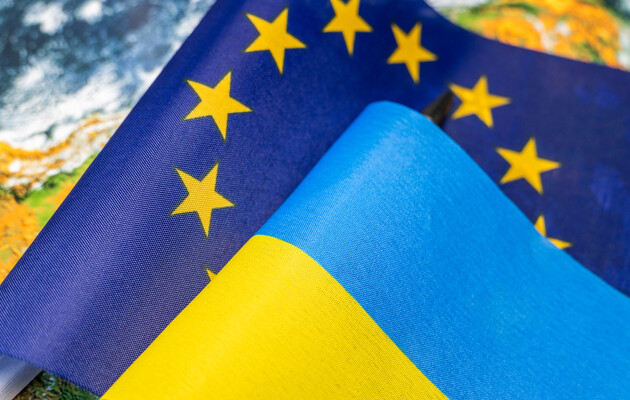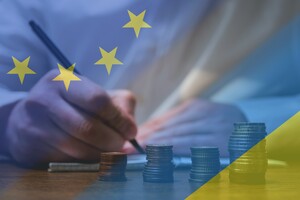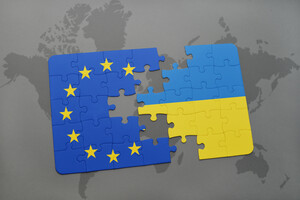Financial and Security Precautions on the Way to the EU
As the opening of negotiations on Ukraine's accession to the European Union approaches, the issues of reliable security guarantees and the adaptation of EU budget mechanisms to the accession of new members are becoming particularly acute for our country. President of the European Commission Ursula von der Leyen emphasized these problems in her September address to the European Parliament.
Even before the current wave of EU enlargement, its weak response to global challenges was on display due to the limited common budget of the European Union. In particular, the former president of the European Central Bank, Mario Draghi, when speaking about the consequences of the pandemic and Russian aggression, pointed to the need to increase the EU’s budgetary capacity.
For many years, the EU budget was subject to a spending limit of 1% of the EU's gross national income (GNI) and the balanced budget rule. At the same time, the expenditure limit was changed several times with an increase to 1.4% of GNI for 2021–2027. Taking into account the RRF anti-Covid fund, the spending limit was temporarily increased to 2.0% of GNI with a planned return to the normal level.
The current EU budget is defined by the Multiannual Financial Framework (MFF) for 2021–2027. Annual expenditures of the EU budget in 2023 and 2024 will slightly exceed 168 billion euros (see table). The policy of economic, social and territorial solidarity of the EU is the largest item of expenditure from the Union budget: in 2023, €62.9 billion will be used in this area.
EU cohesion policy is implemented through the programs of the Regional Development Fund, the Social Fund, the Territorial Mechanism and the EU Solidarity Fund. The latter finances member states whose incomes are below 90% of the EU average, based on population and area.
In Ukraine, in terms of market prices and exchange rates, the gross national income per capita is only 11.5% of the EU average. However, indicators based on purchasing power parity (PPP) are used for the distribution of solidarity policy funds. And the GNI per capita in PPP terms in Ukraine is now about 26% of the EU average.
The Regional Development Fund targets less developed regions with GNI per capita below 75% of the average. Such regions may receive additional benefits related to unemployment, greenhouse gas emissions, and migrant inflows. In the EU, the limit of solidarity spending from all funds is applied to each member state — 2.3% of the country's GDP.
The second item of expenditure from the EU budget (€40 billion per year) is the Common Agricultural Policy (CAP). Average direct payments to farms within the framework of CAP are €255 per hectare. About half of this amount is the “base payment” and the rest is related to special regimes, including “greening.” Poland has set a basic payment of €100 per hectare, but together with other elements, the total amount of subsidies reaches €230 per hectare.
According to Michael Emerson's calculations, if Ukraine were hypothetically already a full-fledged EU member, it could receive €18–19 billion in net transfers from the EU budget. At the current rate of contributions, this would mean an increase in the transfers of all member states to the EU budget by approximately 10% (The Potential Impact of Ukrainian Accession on the EU's Budget).
When comparing this to the current volumes of support for Ukraine, it should be recalled that in July 2023, the EU proposed a new Fund for Ukraine (Ukraine Facility) in the amount of €50 billion for 2024–2027, or an average of €12.5 billion per year.
At the same time, the World Bank estimated the costs of reconstruction of Ukraine at $411 billion, or €383 billion, as of February 23, 2023. If we assume that the reconstruction period will last ten years, then at least €38.4 billion should be directed every year to the restoration of energy and other critical infrastructure of Ukraine, social institutions, housing, demining of territories and support of private businesses.
In March 2023, the IMF estimated Ukraine's macro-financial gap (without aid for reconstruction) at €75.1 billion by 2028. That is, the average annual value of macro-financial support should be €15 billion.
Taking together the annual estimates of 15 billion euros from the IMF and €38.4 billion from the World Bank, we will get the amount of Ukraine’s financing needs — €53 billion per annum. It is worth noting that this is only the minimum amount of needs, which takes into account the damage from Russia’s aggression as of February 23, 2023. That is, the Ukraine Facility with financing at the level of €12.5 billion annually will at best cover one-fourth of the needs.
All the given facts indicate that, concurrently with the progress of Ukraine's integration into the EU, it would be necessary to increase the size of the EU’s common budget.
At present, a vigorous discussion is underway as to the rates and mechanisms of collection of new taxes to the EU budget: tax on unprocessed plastic waste; mechanism of border carbon regulation; digital tax; emissions trading with its spread to buildings and transport; tax on financial transactions.
At the same time, financial support for Ukraine in the near future will require a separate regime for forming the EU budget and directing part of it to the goals of territorial cohesion and reconstruction of Ukraine and raising its income level to the average European level.
In anticipation of the negotiations on Ukraine's accession to the EU, it is important to understand the time frame for obtaining full EU membership. Charles Michel, President of the European Council, and a number of influential experts predict that 2030 will be the EU's target date for accepting new members.
Today, a consensus has already been reached that Ukraine should receive significant financial support from the EU for post-war reconstruction. This support will be structured in such a way as to advance the reforms necessary for EU accession. However, according to Stefan Lehn of Carnegie Europe, Ukraine will have to accept the fact that it will not be included on an equal footing with other members in the CAP and EU cohesion policy for a long time even after joining the Union.
Stefan Lehn argues that it is highly unlikely that the EU will want to increase its budget in the near future to the point of fully integrating Ukraine into the CAP and the cohesion policy. Therefore, there will be room for transitional arrangements with postponing the resolution of important issues until later.
According to Michael Emerson's estimates, if Ukraine becomes a member of the EU in 2030, it is realistic to expect a 10-year transition period for receiving agricultural subsidies, as a result of which the full impact of Ukraine's acceptance on the EU budget will not be manifested until 2040.
The task of the Ukrainian authorities in the negotiation process with the EU is to shorten the transition period as much as possible until the EU budget mechanisms are fully extended to Ukraine. After all, if Ukraine does not come under the influence of standard (or modified) instruments of territorial equalization / the EU solidarity policy and the single agricultural policy during a long transition period, then the recovery of Ukraine, as well as the convergence with the EU, will be weak and slow.
Another challenge for the Ukrainian authorities is to advance the issue of security guarantees for Ukraine with eventual membership in NATO and to prevent a situation in which Ukraine's accession to the EU will be portrayed as a substitute for NATO membership.
The Treaty on the EU has Article 42.7 “Mutual Defense Clause,” which means that Ukraine, being a member of the European Union, will have the right to help other members in case of armed aggression. Article 42.7 of the Treaty on the EU reads as follows: “If a Member State is the victim of armed aggression on its territory, the other Member States shall have towards it an obligation of aid and assistance by all the means in their power, in accordance with Article 51 of the United Nations Charter.”
However, such assistance in the event of repeated aggression by Russia will actually reproduce the current situation, with the allies providing financial and military assistance to Ukraine. At the same time, Ukraine will be deprived of guarantees of collective defense and the use of NATO armed forces to protect its sovereignty and territorial integrity. And precisely such guarantees would become an effective safeguard against further aggressive actions by Moscow.
Carlo Bastasini of the Brookings Center sees several reasons for the significant acceleration of Ukraine's EU accession starting in 2022. First, regardless of the outcome of the Russian-Ukrainian war, it would be too dangerous to leave Ukraine exposed to the threat of permanent instability without EU integration. Second, most European leaders hope that joining the EU will push aside Kyiv's request to join NATO, which, according to these leaders' expectations, could draw the EU into a head-on collision with Russia. Therefore, for the EU and other Western allies, according to Bastasini, the option of Ukraine joining the EU is cheaper compared to alternative mechanisms of support for our country.
Unfortunately, following the results of the NATO summit in Vilnius, it became obvious that there is no unanimity among NATO members regarding Ukraine's accession to the Alliance. Besides, internal disagreements within NATO may weaken its ability to deter Russian aggression. Against this background, Marie Dumoulin, Gustav Gressel and others from the European Council on Foreign Relations argue that the EU and its members should still put on record their obligations to Ukraine, including EU accession and eventual membership in NATO. Moreover, the EU should give priority to work on Ukraine's accession to NATO, since only a safe Ukraine will be able to implement the reforms necessary for joining the EU (Sustain and prosper: How Europeans can support Ukraine).
In their opinion, after the tragic events of 2022–2023, Western allies should realize that countries that remain in the “gray zones” can be attacked by an aggressor, and NATO membership is the most effective way to deter Russia in the long term. In financial terms, money saved on the defense of Ukraine thanks to the collective defense of NATO could be channeled to the recovery of our country. In addition, the NATO security “umbrella” would contribute to the large-scale attraction of private capital to Ukraine.
However, the unfortunate fact is that some NATO members, especially the US, have learned a very different lesson in the 15 years since the Bucharest summit: don't promise what you can't be sure of. Moreover, the Biden administration is unlikely to change its stance on Ukraine's membership in NATO at the Washington summit. Instead, diverting attention from controversial issues, the US administration will try to focus on the commemorative aspects of NATO's 75th anniversary.
And yet, according to experts, there is a small chance that the allies will offer Ukraine to join NATO in 2024, based on the understanding that this would be the strongest deterrent against future Russian aggression. Guaranteeing NATO membership to Ukraine would give investors confidence in taking on commitments related to investments in Ukraine. Similarly, successful reconstruction and economic growth would give Ukraine the opportunity to strengthen its Armed Forces and the potential to prevent new aggression.
It is also important that the military support to Ukraine and its future NATO membership correspond to the interests of not only Ukraine, but also the EU itself. After all, if European politicians take the right steps to support Ukraine, it will become possible to increase military production capacities in the EU and to implement an integrated approach to European defense, thus significantly bolstering the security of the EU and its neighboring countries.
Therefore, supporting Ukraine’s security is a new opportunity for the EU to rethink its policy and make the Union more functional and able to integrate new countries, stabilizing the EU's geopolitical profile and principles of activity. That said, the negotiation process regarding Ukraine's EU accession should go hand in hand with the issues of security guarantees during the war and the possibility of joining NATO after it ends. Only a safe and successful Ukraine will be able to ensure the restoration of long-term peace and prosperity in Europe, as well as the achievement of progressive changes in the process of EU enlargement.
Please select it with the mouse and press Ctrl+Enter or Submit a bug
















 Login with Google
Login with Google